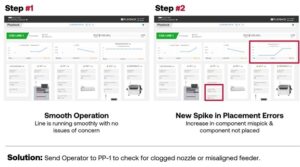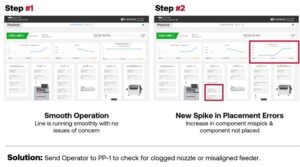How to solve your factory’s problems before it’s too late with live feedback from your SMT assembly lines.
By Jonathan Simard, Product Manager – Analytics & Traceability, Cogiscan
 It’s not a secret for anyone: every SMT factory shoots for a 100% smooth-running operation. While not always realistically achievable, you should still thrive to enhance your factory’s overall efficiency. This objective can be met using industry-specific real time dashboards. Let’s explore how these tools can get you to a seamless SMT line.
It’s not a secret for anyone: every SMT factory shoots for a 100% smooth-running operation. While not always realistically achievable, you should still thrive to enhance your factory’s overall efficiency. This objective can be met using industry-specific real time dashboards. Let’s explore how these tools can get you to a seamless SMT line.
In reality it’s not possible to reach the level of perfection we would all love to have in our SMT factory. However, this article is geared toward helping you solve your line problems more efficiently, saving your most precious resources (time and money!).

The importance of having up to date SMT machine data
A crucial element for everyone who wants to solve problems is to have the right data…and as quickly as possible! We’ve all seen it before: some SMT operations still rely on manual data entry, creating a huge delay in problem detection. Even though this is a viable approach, it’s less than optimal especially if you want to maximize your asset utilization or material usage.
Let’s say you learn about a placement issue that started happening 60 minutes ago. How many PCBAs did you produce in the last hour? Are all of those units in jeopardy?! Think of the wasted cost! A quick and easy solution in this case would be to retrieve accurate data directly from your SMT machines and then instantly feed to a Real Time Dashboard.
Using Real Time dashboards to optimize your SMT assembly lines
Having the right tool is important but knowing how to actually use it is even more crucial. Here are some examples of how you could benefit from Real Time dashboards in your factory.
Example #1: Placement Issues

In this first example, this factory was running an order on their SMT assembly line, CGS LINE 1. Everything was running as it should, but then the production manager noticed a spike in placement errors while looking at this real time dashboard.
Since it was flagged right away, the production manager looked further and noticed an increase in component mispick and component not placed metrices on the placement machine, PP-1. Since he knew exactly what the problem was, and where it was happening, the production manager was then able to send an operator to the right machine immediately in order to check for a clogged nozzle or a misaligned feeder. The problem was quickly solved, and they were able to resume production without losing time or wasting any additional materials.
Example #2: Unplanned Status Change

In this example, the production manager noticed an unplanned status change for the reflow oven, REF-1.
Even though he’s not able to understand the root of them problem by simply looking at the SMT assembly line dashboard, the production manager was still able to send a technician to start investigating the root cause of the problem. Turns out, one of the fans was clogged. While not ideal, the worst was avoided because the issue was found immediately. After a quick maintenance call, production resumed, and the line was back up producing good boards in very little time. In an industry where time is money, you want your machines running in spec as much as possible to increase your ROI.
Not only an efficiency tool
We’ve given you some ways you could use a real time dashboard to optimize your factory, but we hear more and more about the benefit of showcasing dashboards on the actual production lines. Many of our partners and clients talk about the fact that those SMT specialized dashboards distinguish them from their competition when clients come to visit their facilities.
These dashboards will not only help you impress your current clients, but they also come in handy when you need to win other PCB assembly contracts. That’s what we call a 2-for-1.













